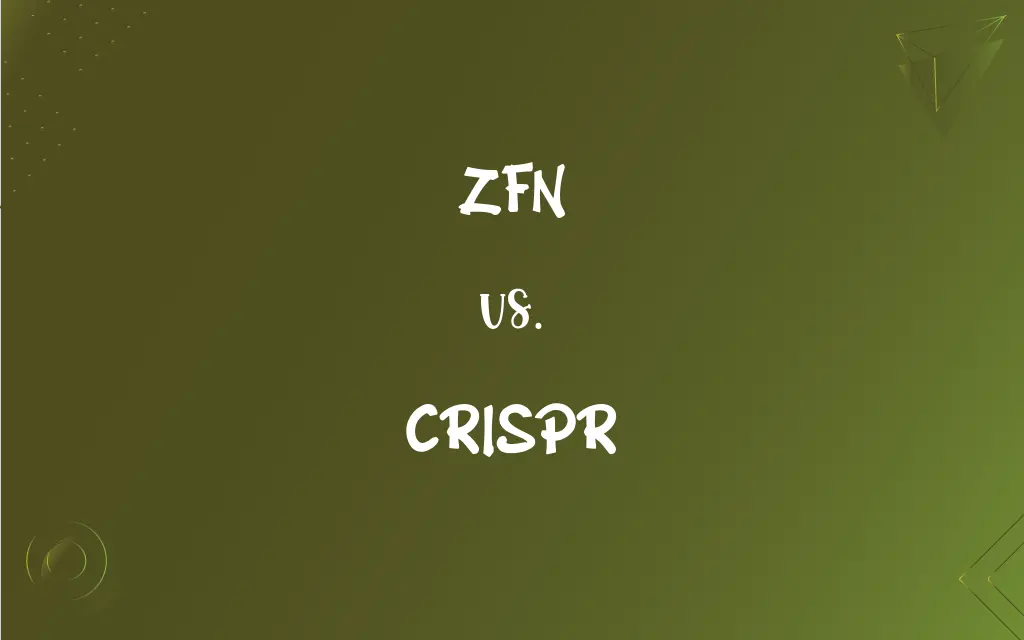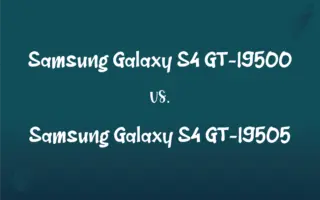ZFN vs. CRISPR: What's the Difference?
Edited by Aimie Carlson || By Harlon Moss || Published on February 3, 2024
ZFN (Zinc Finger Nucleases) uses engineered proteins for genome editing; CRISPR (Clustered Regularly Interspaced Short Palindromic Repeats) utilizes RNA-guided DNA targeting.

Key Differences
ZFN, short for Zinc Finger Nucleases, is a genome editing tool that relies on engineered proteins to target specific DNA sequences. In contrast, CRISPR, which stands for Clustered Regularly Interspaced Short Palindromic Repeats, is a more recent and versatile technology that uses RNA sequences to guide the Cas9 enzyme to the desired DNA location.
In the realm of genetic engineering, ZFN represents an earlier method where custom proteins must be developed for each target DNA sequence, making it a more labor-intensive process. Conversely, CRISPR technology simplifies this process by allowing researchers to easily change the RNA guide, making it a more adaptable and efficient tool for gene editing.
Regarding precision and specificity, ZFNs, although highly accurate, often require complex and time-consuming design for each specific DNA target. On the other hand, CRISPR offers greater ease in targeting different DNA sequences but can sometimes lead to off-target effects due to the simpler guide RNA design.
The cost and accessibility of ZFN are relatively high due to the intricate protein engineering involved. CRISPR, in contrast, is less costly and more accessible to researchers globally, owing to its simpler, RNA-based guide system.
ZFN technology, being older, has a longer history of development and use in various research contexts. CRISPR, while newer, has quickly gained popularity and widespread adoption in the scientific community due to its versatility and ease of use.
ADVERTISEMENT
Comparison Chart
Main Mechanism
Uses engineered proteins
Utilizes RNA-guided enzyme
Ease of Design
Requires complex protein engineering
Simplified by interchangeable RNA guides
Precision
High, but labor-intensive
High, but can have off-target effects
Cost and Accessibility
Generally higher cost and less accessible
More cost-effective and widely accessible
Historical Context
Older, with a longer history of use
Newer, rapidly adopted for its versatility
ADVERTISEMENT
ZFN and CRISPR Definitions
ZFN
ZFN technology involves the fusion of zinc finger DNA-binding domains with a DNA-cleavage domain.
The researchers created a specific ZFN to target a gene associated with a hereditary disease.
CRISPR
CRISPR stands for Clustered Regularly Interspaced Short Palindromic Repeats, a key component of bacterial immune systems.
The study of bacterial CRISPR systems has led to breakthroughs in genetic engineering.
ZFN
ZFNs are engineered DNA-binding proteins that facilitate targeted genome editing.
Scientists used ZFNs to correct a genetic mutation in lab mice.
CRISPR
CRISPR is a revolutionary gene-editing system derived from bacterial defense mechanisms.
CRISPR technology enabled the rapid development of genetically modified crops.
ZFN
Zinc Finger Nucleases (ZFNs) are customizable tools for precise genetic manipulation.
The team used ZFNs to modify a key gene in yeast for industrial applications.
CRISPR
CRISPR has transformed genetic research with its simplicity and effectiveness.
CRISPR has streamlined gene therapy research, offering new hope for treating inherited diseases.
ZFN
ZFNs represent an early generation of genome editing tools preceding CRISPR.
Before CRISPR, ZFNs were the primary method for targeted gene editing in research labs.
CRISPR
CRISPR utilizes a guide RNA sequence to direct Cas9 enzymes to specific DNA sites.
Researchers employed CRISPR to edit a gene responsible for a rare genetic disorder.
ZFN
ZFNs operate by inducing double-strand breaks at specified locations in the genome.
The ZFN-induced break allowed for the insertion of a new gene segment in the plant genome.
CRISPR
CRISPR technology allows for efficient and precise modifications of DNA in various organisms.
Using CRISPR, scientists successfully introduced a beneficial trait into a species of fish.
FAQs
What is ZFN?
ZFN stands for Zinc Finger Nucleases, a type of engineered protein used for precise genome editing.
How does CRISPR work?
CRISPR works by using a guide RNA sequence to direct the Cas9 enzyme to specific DNA locations for editing.
Can ZFN and CRISPR edit any gene?
Both ZFN and CRISPR can target most genes, but their efficiency and specificity can vary depending on the target sequence.
Are there any risks associated with using ZFN?
ZFN can potentially cause off-target effects or unintended mutations, though it is generally precise.
What makes ZFN different from CRISPR?
ZFN uses engineered proteins for targeting DNA, while CRISPR uses RNA guides, making CRISPR more versatile and easier to design.
What are the applications of ZFN?
ZFN is used in gene therapy, functional genomics, and the development of transgenic models.
Is CRISPR more effective than ZFN?
CRISPR is generally considered more versatile and easier to use than ZFN, though both have high precision in targeting DNA.
What are the applications of CRISPR?
CRISPR is used in gene editing, functional genomics, disease modeling, and developing gene therapies.
Are there any risks associated with using CRISPR?
CRISPR can also lead to off-target effects and requires careful design to minimize unintended edits.
What ethical considerations surround ZFN and CRISPR?
Ethical considerations include potential long-term effects, gene editing in humans, and environmental impacts.
How was CRISPR discovered?
CRISPR was discovered as a part of the bacterial immune system and adapted for genome editing.
Can ZFN and CRISPR be used in humans?
Both can be used in human cells, but ethical and safety considerations limit their application in clinical settings.
What is the future of ZFN and CRISPR technologies?
Both technologies are evolving, with ongoing research to enhance their precision, efficiency, and safety.
How does the cost of using ZFN compare to CRISPR?
Generally, CRISPR is less expensive and more accessible than ZFN due to its simpler design requirements.
How do ZFN and CRISPR impact biodiversity?
They can be used to alter species' genetics, impacting biodiversity, but this requires careful consideration of ecological effects.
Is ZFN still used today?
Yes, ZFN is still used, particularly in cases where its specific protein-based targeting is advantageous.
Can ZFN and CRISPR cure genetic diseases?
They have the potential to treat genetic diseases, but research and clinical trials are ongoing to determine their efficacy and safety.
What training is required to use ZFN and CRISPR?
Researchers typically need specialized training in molecular biology and genetics to use these technologies effectively.
How was ZFN developed?
ZFN was developed by fusing zinc finger DNA-binding domains with a DNA-cleavage domain.
Has CRISPR replaced ZFN in genetic research?
While CRISPR is more popular, ZFN still has applications, particularly in scenarios requiring its unique attributes.
About Author
Written by
Harlon MossHarlon is a seasoned quality moderator and accomplished content writer for Difference Wiki. An alumnus of the prestigious University of California, he earned his degree in Computer Science. Leveraging his academic background, Harlon brings a meticulous and informed perspective to his work, ensuring content accuracy and excellence.
Edited by
Aimie CarlsonAimie Carlson, holding a master's degree in English literature, is a fervent English language enthusiast. She lends her writing talents to Difference Wiki, a prominent website that specializes in comparisons, offering readers insightful analyses that both captivate and inform.































































